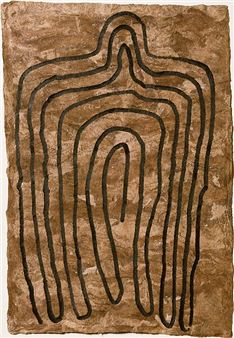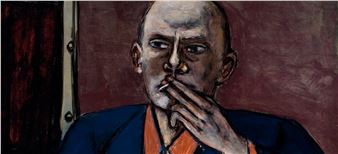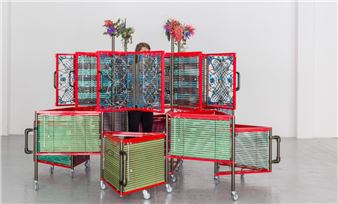Precarious Worlds: Contemporary Art from Germany
The artworks—by artists such as Franz Ackermann, Thomas Demand, Sergey Jensen, and Corinne Wasmuht—investigate issues relating to digitization, material instability, and the individual’s attachment to, and detachment from, historical notions of place. Also on view will be significant pieces, already in the Museum collection, by Michel Majerus, Manfred Pernice, and Wolfgang Tillmans, as well as a large-scale installation, on loan, by Hans-Peter Feldmann.
Some of the artists in this exhibition give form to conditions of instability and fragility without reference to particular contemporary or historical moments. Sergej Jensen, for example, creates precarious and fragile textile objects by sewing together and staining found pieces of fabric. By contrast, Franz Ackermann thematizes the tourist and urban wanderer as specifically central to contemporary culture, concurrently dwelling on both attachment and detachment to place as part of a geographically shifting world.
Photography too plays an important role in these works. Both Thomas Demand and Wolfgang Tillmans create large-scale works deliberately devoid of an original, causing sensations of unease. By emphasizing an absent original and divorcing the photograph from its indexical referent—a certain moment or event in time—both artists illuminate through inventive uses of the medium of photography memory and history as fictional, instable, or even inaccessible. Another theme that emerges in this exhibition involves the blurring of boundaries between visibility and invisibility within a single image. Corinne Wasmuht and Michel Majerus, for example, have paradoxically responded to the flickering effects of digitization with large-scale paintings. Wasmuht’s Llangancuo Falls (2008) and Michel Majerus’s mm6 (2001) both deny perspectival orientation to demonstrate that we cannot, despite digital technologies, see everything at once.
Support for Precarious Worlds: Contemporary Art from Germany is generously provided by James M. Kemper, Jr., and the David Woods Kemper Memorial Foundation. Curated by William T. Kemper Director and Chief Curator Sabine Eckmann, the exhibition will remain on view through January 9, 2012.
Exhibition catalog
A fully illustrated color catalog will accompany the exhibition, which includes texts by Sabine Eckmann and Svea Braeunert, and full color photography.

Recommended for you
The artworks—by artists such as Franz Ackermann, Thomas Demand, Sergey Jensen, and Corinne Wasmuht—investigate issues relating to digitization, material instability, and the individual’s attachment to, and detachment from, historical notions of place. Also on view will be significant pieces, already in the Museum collection, by Michel Majerus, Manfred Pernice, and Wolfgang Tillmans, as well as a large-scale installation, on loan, by Hans-Peter Feldmann.
Some of the artists in this exhibition give form to conditions of instability and fragility without reference to particular contemporary or historical moments. Sergej Jensen, for example, creates precarious and fragile textile objects by sewing together and staining found pieces of fabric. By contrast, Franz Ackermann thematizes the tourist and urban wanderer as specifically central to contemporary culture, concurrently dwelling on both attachment and detachment to place as part of a geographically shifting world.
Photography too plays an important role in these works. Both Thomas Demand and Wolfgang Tillmans create large-scale works deliberately devoid of an original, causing sensations of unease. By emphasizing an absent original and divorcing the photograph from its indexical referent—a certain moment or event in time—both artists illuminate through inventive uses of the medium of photography memory and history as fictional, instable, or even inaccessible. Another theme that emerges in this exhibition involves the blurring of boundaries between visibility and invisibility within a single image. Corinne Wasmuht and Michel Majerus, for example, have paradoxically responded to the flickering effects of digitization with large-scale paintings. Wasmuht’s Llangancuo Falls (2008) and Michel Majerus’s mm6 (2001) both deny perspectival orientation to demonstrate that we cannot, despite digital technologies, see everything at once.
Support for Precarious Worlds: Contemporary Art from Germany is generously provided by James M. Kemper, Jr., and the David Woods Kemper Memorial Foundation. Curated by William T. Kemper Director and Chief Curator Sabine Eckmann, the exhibition will remain on view through January 9, 2012.
Exhibition catalog
A fully illustrated color catalog will accompany the exhibition, which includes texts by Sabine Eckmann and Svea Braeunert, and full color photography.
Contact details


 ARTISTS
ARTISTS















